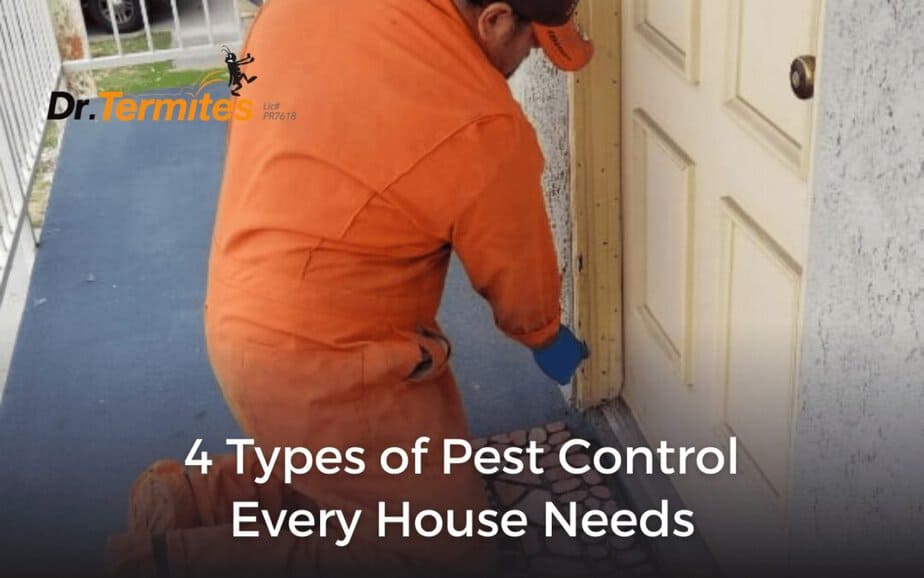
by pestcontrolseos | Sep 4, 2024 | Blog, Pest Info & Articles
When it comes to keeping your home safe and comfortable, dealing with pests is a key part of the process. Pests can cause significant damage and pose health risks to your family. That’s why professional pest control is essential. This blog post will cover four types of pest control that every house needs: general pest control, rodent control, termite control, and bed bug control. Understanding these services can help you maintain a pest-free home and ensure the well-being of your household.

General Pest Control
General pest control is the first line of defense against common household pests. This service typically covers a wide range of insects and critters, including ants, spiders, and cockroaches. Regular treatments help prevent infestations before they start, protecting your home from unwanted guests. Professionals use safe and effective products to treat known hotspots in and around your home, creating a barrier that keeps pests out.
Seasonal Treatments
Residential pest control services often include seasonal treatments to address the specific pests that are more active during certain times of the year. This proactive approach ensures that your home remains secure year-round, minimizing the risk of infestations.
Benefits of General Pest Control
- Health Protection: Keeps harmful pests away, reducing the spread of diseases.
- Property Preservation: Protects furniture and home infrastructure from damage.
- Peace of Mind: Regular treatment schedules mean fewer worries about surprises.
Common Pests Covered
- Ants: Can contaminate food supplies and damage structures.
- Spiders: Some can be venomous; control is necessary to prevent bites.
- Cockroaches: Known for spreading germs and causing allergies.
Rodent Control
Rodents, such as mice and rats, can cause extensive damage to your home. They chew through wires, insulation, and even structural elements, leading to costly repairs. Professional rodent control involves identifying entry points, setting traps, and using bait stations to reduce rodent populations.
Preventive Measures
Experts also focus on preventive measures like sealing gaps and holes where rodents might enter. By addressing these vulnerabilities, residential pest control services help prevent future infestations, keeping your home rodent-free.
Additional Focus Areas
- Sanitation Practices: Keeping food sealed and trash covered to avoid attracting rodents.
- Ongoing Monitoring: Regular checks to ensure that preventive measures are working.
Health Risks of Rodents
- Disease Transmission: Rodents can carry diseases like hantavirus and salmonella.
- Allergy Trigger: Rodent droppings can trigger allergies in sensitive individuals.
Termite Control
Termites are known for silently destroying homes from the inside out. These insects feed on wood and can cause significant structural damage if not addressed promptly. Professional termite control is crucial for detecting and eliminating these pests.
Inspection and Treatment
Termite control begins with a thorough inspection of your home to identify any signs of termite activity. Once detected, professionals use treatments such as liquid barriers or bait systems to eliminate termites and protect your home. Regular inspections are recommended to ensure that termites do not return.
Signs of Termite Activity
- Mud Tubes: Small tubes along walls or foundations.
- Hollow Wood: Wood that sounds hollow when tapped.
- Discarded Wings: Found near windows or doors.
Importance of Early Detection
- Cost Savings: Early detection can prevent costly repairs.
- Structure Safety: Protects the structural integrity of your home.
Bed Bug Control
Bed bugs are small but mighty pests that can cause sleepless nights and itchy bites. They are notoriously difficult to eliminate without professional help, as they hide in mattresses, furniture, and even cracks in the walls.
Comprehensive Solutions
Professional bed bug control involves a comprehensive approach, including heat treatments, chemical applications, and thorough inspections. These methods ensure that all bed bugs and their eggs are eradicated, providing you with peace of mind and a good night’s sleep.
Tips to Identify Bed Bugs
- Bite Marks: Itchy red welts on skin, often in a line.
- Dark Spots: Bed bug excrement on sheets or mattresses.
- Musty Odor: A strange, musty smell in the affected areas.
Why Professional Help is Crucial
- Effective Eradication: Professionals have the tools and knowledge for complete elimination.
- Prevention Tips: Expert advice on preventing future infestations.
Guarding Your Sanctuary: The Essential Guide to Residential Pest Control
Professional pest control is not a luxury; it’s a necessity for maintaining a safe and healthy home. By investing in residential pest control services, you can effectively manage and prevent infestations of common pests like rodents, termites, and bed bugs. Remember, each type of pest requires a specific approach, and professionals are equipped with the knowledge and tools to handle them efficiently. Protect your home and family by making pest control a regular part of your home maintenance routine. Regular inspections and treatments can save you from costly repairs and ensure that your living space remains a haven for you and your loved ones.
Don’t let pests take over your sanctuary. Choose Dr. Termites for top-tier residential pest control in Ventura. Our expert team guarantees a pest-free home with our efficient, tailored solutions. Act now to protect your home and family—schedule your inspection with Dr. Termites today!
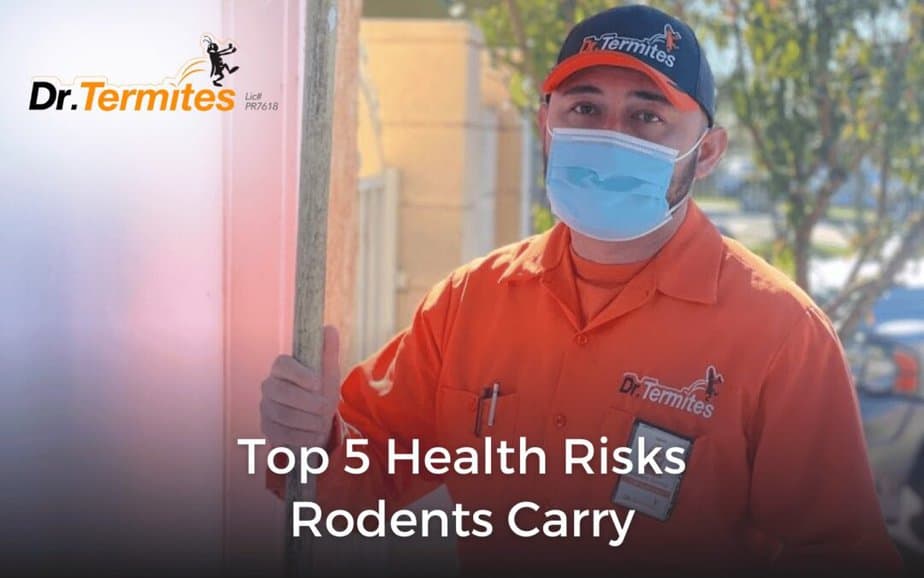
by pestcontrolseos | Aug 30, 2024 | Blog, Pest Info & Articles
Rodents such as rats and mice are more than just pests. Apart from causing damage to property, they can pose serious health risks to humans. These small animals often live close to us, which increases the chance of diseases spreading. Understanding these health risks is important for keeping ourselves and our families safe. In this blog post, we will go through the top 5 health risks that rodents carry.

1. Hantavirus
What is Hantavirus?
Hantavirus is a serious illness spread by rodents, especially deer mice. It can cause severe respiratory issues and even be fatal in some cases.
How is it Transmitted?
You can get hantavirus by coming into contact with rodent urine, droppings, or saliva. It can also spread through airborne particles when cleaning areas where rodents have been.
Symptoms
Symptoms of hantavirus include fever, muscle aches, and fatigue. As the disease progresses, it can lead to coughing and shortness of breath.
Prevention
To prevent hantavirus, avoid coming in contact with rodent droppings and nests. Wear gloves and masks when cleaning areas where rodents have been. Ensure your home is sealed to prevent rodent entry.
2. Salmonella
What is Salmonella?
Salmonella is a type of bacteria that can cause food poisoning. Rodents can carry this bacteria and spread it through their droppings.
How is it Transmitted?
You can get salmonella by eating food or drinking water contaminated with rodent droppings. This bacteria can also spread through contact with surfaces where rodents have been.
Symptoms
Symptoms of salmonella include diarrhea, stomach cramps, and fever. These symptoms can be severe and lead to dehydration, especially in young children and older adults.
Prevention
Keep your living areas clean and store food in sealed containers. Wash your hands thoroughly after handling food and before eating. Regularly clean surfaces to reduce the risk of contamination.
Leptospirosis
What is Leptospirosis?
Leptospirosis is a bacterial disease that affects both humans and animals. It is more common in warmer climates and can lead to serious health issues.
How is it Transmitted?
Rodents shed the bacteria in their urine, which can contaminate water and soil. Humans can get leptospirosis through contact with contaminated water or soil, especially through cuts and abrasions.
Symptoms
Symptoms include fever, headache, chills, muscle aches, and vomiting. In severe cases, it can lead to kidney damage, liver failure, or even death.
Prevention
Avoid swimming in or drinking water that might be contaminated. Wear protective clothing if you are working in water or soil that could be infected. Keep your environment clean and free of rodent infestations.
4. Plague
What is the Plague?
The plague is a severe illness caused by the bacteria Yersinia pestis. It has a historical reputation but is still present in some areas today.
How is it Transmitted?
Rodents, particularly rats, can carry fleas that are infected with the plague bacteria. Humans can get the plague through flea bites or direct contact with an infected animal.
Symptoms
Symptoms include fever, chills, weakness, and swollen lymph nodes. If not treated promptly with antibiotics, it can be fatal.
Prevention
Control rodent populations around your home and wear insect repellent to avoid flea bites. Seek medical attention immediately if you suspect you have been exposed. Keep your pets free of fleas as they can also carry the infection.
5. Rat-Bite Fever
What is Rat-Bite Fever?
Rat-bite fever is a bacterial infection that humans can get from rodents. It is not very common but can be quite serious.
How is it Transmitted?
The disease is transmitted through bites or scratches from rodents or by handling rodents and then touching your mouth, nose, or eyes.
Symptoms
Symptoms include fever, rash, and joint pain. If left untreated, it can lead to severe complications like infections in the heart, brain, or lungs.
Prevention
Avoid handling rodents, and if you do, wear gloves and wash your hands thoroughly afterward. Seek medical attention if you are bitten or scratched by a rodent. Ensure your home is rodent-free to minimize risk.
Protect Your Health: Effective Strategies to Combat Rodent-Borne Diseases
Not only are rodents an annoyance, but they also provide significant health hazards. These illnesses, which range from leptospirosis, plague, and rat-bite fever to hantavirus and salmonella, can seriously harm human health. Knowing the risks can help us take steps to prevent rodent infestations and protect our well-being. Always maintain cleanliness, secure food sources, and seek professional pest control if you suspect a rodent problem. Stay safe and healthy by being aware of these health risks rodents carry. Taking these preventative measures can significantly reduce the risk of rodent-borne diseases and keep your family safe.
Struggling with rodents? Don’t let them compromise your health! Contact Dr. Termites for premier rodent control in Ventura. Our expert team ensures your space is safe and rodent-free. Act now to protect your family from the dangers of rodent-borne diseases. Call us today for a healthier tomorrow!

by pestcontrolseos | Aug 16, 2024 | Blog, Pest Info & Articles
In the current world, most people want their way of life to rhyme with the environment. One of the best means of doing this is by applying treatment that is environmentally friendly. This could be for pest control reasons, cleaning, and gardening. One such treatment is the orange oil treatment in Ventura. People apply this to get rid of pests. In this blog post, we will look at the benefits of choosing eco-friendly treatments.

Safer for Humans and Pets
Eco-Friendly Pest Control
Since conventional pest control treatments can be harmful to people and pets, people are becoming more worried about the chemicals used in pest control. For every insect issue, orange oil treatment provides a safer substitute. This technique makes use of oil that is extracted from orange peels, which is still effective but less toxic than many chemicals. Families that have small children or pets should pay particular attention to this since they are more susceptible to poisons.
Healthier Indoor Air
Green treatments naturally enhance your home’s air quality, unlike chemical treatments that release harmful toxins. Natural alternatives, like orange oil, don’t pollute the air, making it safer to breathe. This leads to fewer respiratory issues and a healthier living environment.
Good for the Environment
Reducing Chemical Runoff
One key advantage of eco-friendly treatments is their minimal environmental impact. Chemical treatments often lead to runoff, poisoning rivers, lakes, and wildlife. Environmentally safe alternatives reduce harmful chemicals entering water bodies, crucial for protecting ecosystems and ensuring safe drinking water for future generations.
Lower Carbon Footprint
The potential of green treatments to reduce your carbon impact is another justification for using them. By using these solutions, you’re not only saving the environment but also your house because they frequently use less energy and emit less pollutants. For instance, the orange oil treatment uses a natural pest control technique that lowers overall carbon output by avoiding the greenhouse gas emissions linked to chemical manufacture.
Efficient and Long-term
Organic Pest Control
Many think chemical treatments outlast natural ones, but that’s a myth. For instance, orange oil treatment effectively eradicates termites by breaking their exoskeletons, leading to their death. Homeowners who’ve switched to this natural, chemical-free method have seen lower pest levels.
Long-Lasting Results
Another benefit of these treatments is their long-term effectiveness. They naturally repel pests for extended periods, meaning fewer treatments are needed over time. This long-lasting performance also means less time and money spent on repeated treatments, ensuring a pest-free home with less hassle.
Cost-Effective
Lower Overall Costs
Green treatments may seem costly at first, but they save money in the long run by reducing the need for frequent treatments. This leads to significant savings. Additionally, eco-friendly treatments enhance your home’s value, making them a wise financial choice.
Fewer Health Costs
Another cost benefit derives from the fact that these treatments are safer. Fewer chemicals translate into fewer health problems. This can be both in saving on medical bills and enhancing quality of life. Families that switch to eco-friendly treatments often report fewer allergies and skin problems, thus less visiting doctors and medications.
Easy to Use
Simple Application Process
Many green treatments are easily accessible to use. Orange oil treatment, for example, requires no special equipment nor training. This would be easier for homeowners when needing to do their treatments. With an application process that easy, you would be compelled always to seek professional services for treatment, leaving more control in the homeowners’ hands when dealing with pests in your home
Less Maintenance
Quite self-sufficient and highly effective, these treatments call for very minimal maintenance because they offer long-term solutions. This will ensure that you spend less time treating your home and more on cherished activities at home. Reduced usage and maintenance will mean less interference with your everyday lives, hence enjoying uninterrupted comfort and peace of mind.
Embrace a Greener Future: Go for Eco-friendly Pest Control Solutions
Selecting eco-friendly therapies has several advantages. They are typically more economical in the long run, safer for humans and their pets, and better for the environment. Orange oil treatment, for example, demonstrates that becoming green doesn’t have to mean sacrificing efficacy. You may improve both the environment and your house by switching to eco-friendly products. Eco-friendly pest control methods provide a viable and efficient substitute, regardless of the type of pest problem you’re facing or your preference for healthier cleaning products.
Take the first step toward a more healthy, greener home by choosing Dr. Termites for your pest control needs. Our commitment to eco-friendly solutions, such as orange oil treatment in Ventura, is your peace of mind that you are doing more for the planet other than at least protecting your home. Don’t wait until pests turn into a nightmare. Contact Dr. Termites today and take up a safer, more sustainable way of keeping your home pest-free.
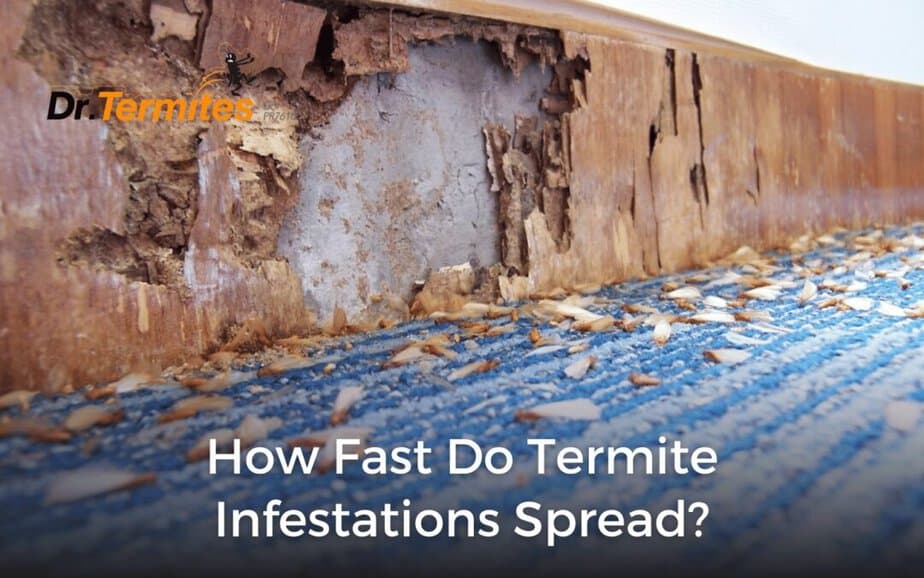
by pestcontrolseos | Aug 9, 2024 | Blog, Pest Info & Articles
Termites are small pests that can pose big problems. They are hard to spot, and if not controlled, might spread really fast. One of the common questions most homeowners ask is how fast termite infestations spread since the damage they can cause is pretty important. Living in Ventura or any other termite-prone zone, it becomes essential to know their behavior and the ways to control them. This blog will explore how fast termites spread and the importance of termite control in Ventura.
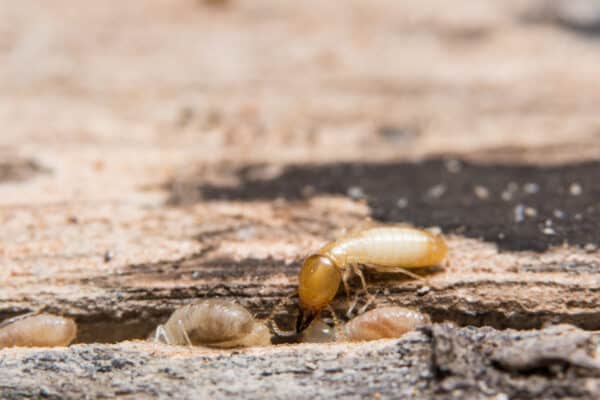
Macro termites are feeding
How Termites Spread
Understanding Termite Colonies
Termites live in colonies; these colonies may be large and complex; a single colony can house thousands to millions of termites. Within every colony, different roles are available, having worker termites in charge of finding food outside the nest and carrying it home. This food foraging spreads them out, often entering homes and buildings.
Routes of Infestation
Termites will find their way into your house in many ways. Most of the time they build mud tubes to move from the colony to some food source. Such tubes act not only as a means of protection from predators but also help them preserve moisture. Other possible points of entry are the cracks in the foundation, openings around windows and doors, and through the plumbing lines. After gaining entrance into your home, they begin the search for wood to feed on.
Causes of Termite Infestation
Climatic Conditions
This could affect the termite growth rate. Termites live best in warm, humid climates. The relatively mild climate of Ventura allows for a perfect setting for termites to thrive. When conditions go right, termites reproduce faster and increase in population more rapidly.
Food Sources
Termites consume cellulose, which they can get from other plants and wood. Wooden beams, furnishings, and even paper goods are commonplace in houses. Consequently, termites have an abundance of food to feed on and grow. The rate of infestation increases with the amount of food available.
Termite Infestation Symptoms
Visible Damage
The initial sign of a termite infestation will be visual damage to wood. This can include hollow-sounding wood, small holes, and easily crumbling wood. If you suspect seeing such signs, it is crucial to react quickly.
Mud Tubes
Mud tubes are one of the most typical signs of termite activity, as was previously indicated. Along walls, foundations, and other architectural features, these tubes are frequently seen. They provide proof that termites have actually invaded the building and are proliferating.
Swarmers
Termites with wings that depart from their colony to establish new ones are known as swarmers. A strong clue that an infestation is either ongoing or about to happen is the presence of swarmers within your house.
Termite Control in Ventura: Why It Is Crucial
Prevention of Damage
Thus, termite control in Ventura is quite necessary to prevent huge damages to houses and buildings. Early detection and treatment can save the owners of the house from expansive repairs in their respective homes. Regular inspections by professionals identify and eliminate termite colonies before they have caused too much damage.
Protecting Property Value
A termite infestation can reduce the value of your property. This is because potential buyers may be wary about purchasing a home with a history of termite issues. Termite control protects your property’s value and ensures that the place is safe to live in.
Peace of Mind
Having peace of mind regarding termite infestation of your home is priceless. You can rest easy at night and save yourself the worry of unseen damage or potential repair costs. A termite-free status for the home, combined with regular inspection services and treatments, provides professional termite control.
Help Safeguard Your Home: Efficient Termite Control and Prevention Strategies
Termite infestations have a rather rapid rate of propagation, which often results in severe damages to homes. It is very important that one as a homeowner be aware of how termites spread and know the symptoms of an infestation. The environmental conditions, food sources, and structure of your home can impact how fast the termites are spreading. Keeping off these destructive pests by Ventura termite control is very important to avoid damage, protect property value, and put the mind of the homeowners at peace. Regular inspections with prompt treatment will help you keep your home safe from these nasty creatures. Let not your protective measure be too late; be proactive in safeguarding your house from the termite attack.
Protect your home today by choosing Dr. Termites! Our experts never compromise in offering the best solutions of termite control in the city. We know how urgent termite infestations can be and take pride in solving these issues to prevent damage and preserve your property’s value. No more days should be wasted in terms of bringing peace of mind and protection from house destroyers. Call us or visit our website to schedule your inspection today!
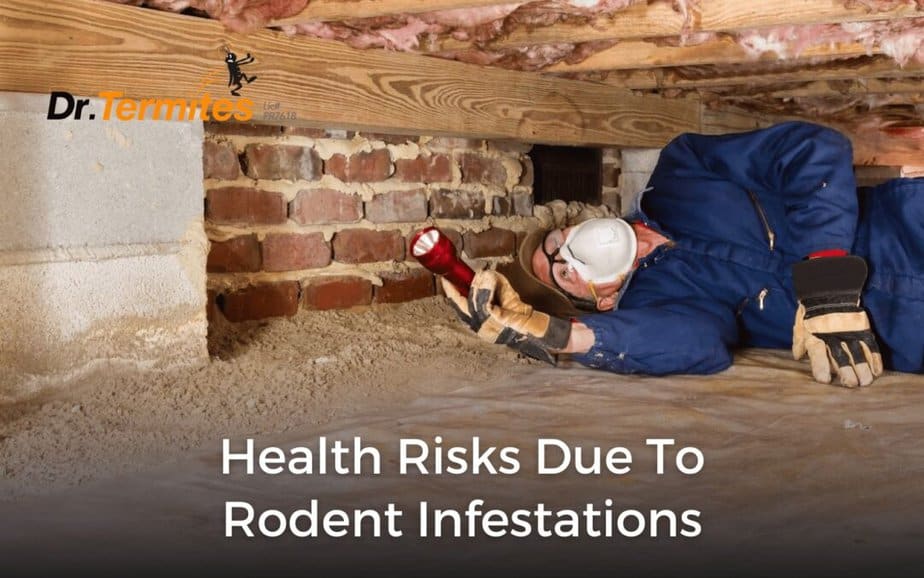
by pestcontrolseos | Aug 2, 2024 | Blog, Pest Info & Articles
Rodents are half the nuisance they really are—serious health risks to humans and pets. Starting from infectious diseases to allergic reactions, rodents can disrupt the safety and health of a household. The following blog will talk about the potential health risks associated with rodent infestations and the importance of effective rodent control in Ventura.
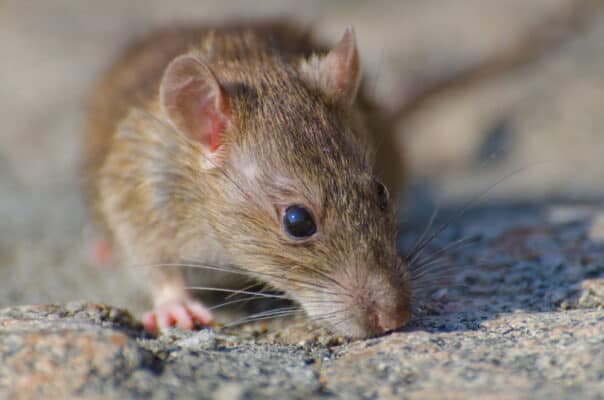
The Spread of Diseases
Hantavirus
Hantavirus, spread by rodents, especially deer mice, is found in their urine, droppings, and saliva. Inhaling dust with these particles can lead to infection. Symptoms are fever, muscle aches, and fatigue, which can escalate to serious respiratory problems or death if untreated. Effective rodent control in Ventura is essential to prevent these health risks.
Leptospirosis
Leptospirosis is a rodent-borne illness, basically caused by water or soil contaminated with their urine. It may cause a very mild flu-like illness but also includes serious illnesses like hepatic damage, renal failure, and meningitis. Serious health complications can be avoided only if the correct diagnosis is made earlier and proper control over rodent populations is taken.
Salmonella
Rodents are a source for Salmonella, a food poisoning organism. Droppings of rodents contaminate food and food-preparation surfaces, resulting in diarrhea, fever, and stomach cramps. Prevent rodent infestations to help protect foods and reduce risk to human disease.
Allergic Reactions
Asthma and Respiratory Issues
The excreta, urine, and saliva of rodents can act as allergy triggers for sensitive persons. These allergens are capable of provoking attacks in people with asthma and other respiratory ailments, especially children. Rodent dead bodies can also act as a source of allergy. Keeping the house free from rodents is very essential for asthmatic or other respiratory patients.
Skin Irritations
Contact with rodent nests, droppings, or urine can cause skin irritations. Some people might develop rashes or other skin problems when they come into contact with rodent-contaminated areas. Ensuring proper rodent control in Ventura can minimize these skin-related health issues.
Contamination of Food and Water
Foodborne Illnesses
Rodents contaminate foodstuffs with droppings, urine, and saliva. These drops can bring many foodborne diseases, very serious for small children, elderly people, and people with low resistibility. Keeping your home clean and ensuring proper storage of foodstuffs against these ailments can be ensured.
Water Contamination
Rodents can also contaminate water resources. Water intake or use, if contaminated by them, would mean falling victim to many diseases, among them Leptospirosis and other water-borne bacteria. Ensuring that the sources of water are free from contamination by these rodents is another key feature of health and safety maintenance.
Structural Damage and Fire Hazards
Chewing on Wires
These pests have the natural propensity for chewing, from wood and clothing down to electrical wires. It can be a cause for short circuits and can also be highly combustible to fire risks in the house. Control of rodents with regular inspections is able to evade such dangerous situations.
Nesting in Insulation
Wall cavities and attic insulation are common places for rodent nesting. Structural issues and occasionally even fires might result from the damage this causes. A house that has been sealed against rodent invasion avoids risks as well as potentially costly and time-consuming repairs.
Prevention and Control
Keeping a Clean Environment
One of the best ways to prevent an infestation is by keeping your house clean and tidy. This would essentially mean that you store your food neatly, manage wastes, and seal up holes and cracks through which rodents may enter your premises. Elementary steps like these can transform the situation completely in regard to keeping your house free from rodents.
Professional Rodent Control in Ventura
Professional rodent control services are very important to the residents of Ventura. They will offer the service of ascertaining the degree of invasion, remove the rodents, and take measures to fix the problem to avoid further invasion. Rodent control experts in Ventura guarantee tailored solutions that keep your home safe and healthy.
Importance of Timely Action
Preventing Health Risks
Timely interventions in controlling rodent infestations at individual levels prevent the spread of diseases and other related health risks. This becomes quite important to those households that have children at tender age, the elderly, or even pets. Early intervention can save lives and block serious health complications.
Protecting Property
Rodent infestations can cause significant damage to property. By addressing the issue promptly, homeowners can prevent costly repairs and ensure their home remains safe. Professional rodent control in Ventura can provide the necessary expertise to protect your property from damage.
The Critical Importance of Professional Rodent Control
Rodent contamination can be associated with health risks, from diseases to allergic reactions. Effective rodent control goes a long way to assure that the living atmosphere is kept safe and healthy. With proactive measures and professional help, families will be able to protect their health and property from the dangers of rodent infestations. Keeping the environment clean and carrying out regular inspections are among the preventive steps taken. Do not wait until it is really too late—act now and ensure a rodent-free home.
Reach out to Dr. Termites today and take the first step towards securing your home from unwanted guests. Our team of experienced professionals specializes in comprehensive rodent control solutions, including the use of orange oil, tailored to ensure your property remains safe, healthy, and rodent-free. Contact us for a consultation and discover the difference professional pest management can make.
Call Dr. Termites today and be the first step toward safeguarding your home from those unwanted guests. Our team of skilled professionals is specializing in state-of-the-art rodent control solutions, including orange oil treatments, tailored to have your property kept safe, healthy, and rodent-free. Contact us for a consultation and see how professional pest management makes all the difference.
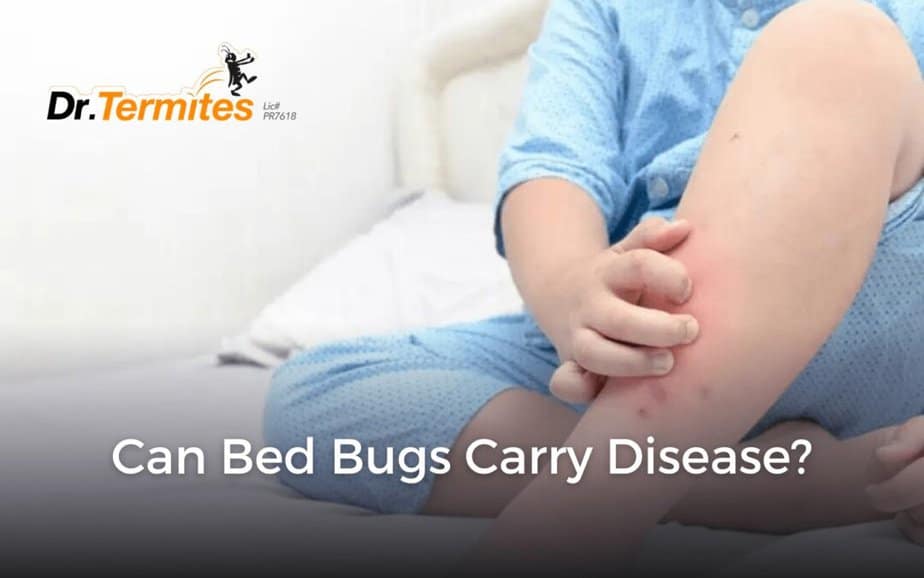
by pestcontrolseos | Jul 26, 2024 | Bed Bugs, Blog
Bed bugs are small, flat insects that feed on the blood of humans and animals. They are often found in beds, furniture, and other places where people sleep or rest. There is growing concern about whether bed bugs can carry disease and what risks they pose to our health. This article will look at the potential dangers of bed bugs and discuss effective ways to control them, especially focusing on Bed Bug Control in Ventura.
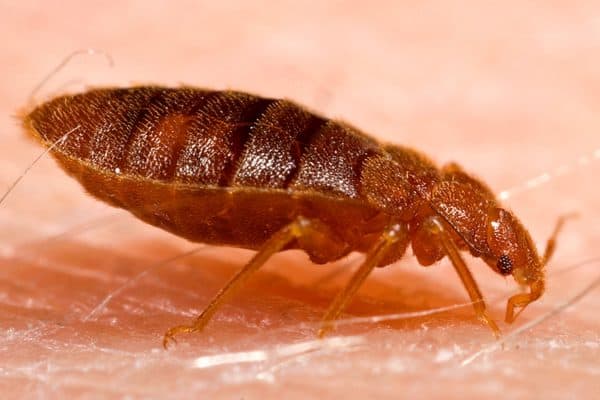
What Are Bed Bugs?
Bed bugs are tiny insects that belong to the family Cimicidae. They are reddish-brown and can be seen with the naked eye. Bed bugs are known for their ability to hide in small cracks and crevices, making them hard to detect and eliminate. They come out at night to feed on the blood of their hosts.
How Do Bed Bugs Spread?
Bed bugs can spread easily from one place to another. They can hitch a ride on luggage, clothing, used furniture, and other items. This makes it easy for them to infest homes, hotels, and other places where people live and work. Once they find a suitable environment, they can quickly multiply and become a major problem.
Can Bed Bugs Transmit Disease?
There has been much debate about whether bed bugs can carry disease. Unlike mosquitoes or ticks, bed bugs are not known to be major carriers of diseases that affect humans. However, their bites can cause a range of health issues.
Health Risks of Bed Bug Bites
While bed bugs are not known to transmit diseases, their bites can still lead to several health problems:
- Allergic Reactions: Some people may have allergic reactions to bed bug bites, which can cause itching, swelling, and redness.
- Secondary Infections: Scratching the bites can lead to secondary infections, such as impetigo or cellulitis, due to bacteria entering the skin.
- Mental Health Issues: The presence of bed bugs can cause stress, anxiety, and sleep disturbances, which can impact overall well-being.
How to Identify Bed Bug Bites
Bed bug bites often appear as small, red, and itchy bumps on the skin. They are usually found in clusters or lines on areas of the body that are exposed while sleeping, such as the arms, legs, face, and neck. It is important to note that not everyone reacts to bed bug bites in the same way. Some people may not show any signs of being bitten, while others may have severe reactions.
Effective Bed Bug Control in Ventura
If you suspect that you have a bed bug infestation, it is important to take immediate action to control the problem. Here are some steps you can take to get rid of bed bugs:
Inspect and Clean
- Inspect Your Home: Check your mattresses, box springs, bed frames, and other furniture for signs of bed bugs. Look for small reddish-brown bugs, shed skins, and tiny black fecal spots.
- Clean Thoroughly: Wash all bedding, curtains, and clothing in hot water and dry them on the highest heat setting. Vacuum your entire home, including carpets, floors, and furniture. Dispose of the vacuum bag in a sealed plastic bag.
Use Bed Bug Treatments
- Insecticides: Use insecticides that are labeled for bed bug control. Follow the instructions carefully to ensure safe and effective use.
- Bed Bug Traps: Place bed bug traps under the legs of your bed and furniture to catch and monitor bed bugs.
Seek Professional Help
If your bed bug problem persists, it may be time to seek professional help. Pest control experts have the knowledge and tools to effectively eliminate bed bugs from your home. For those living in Ventura, there are many options for Bed Bug Control in Ventura that can help you deal with the infestation.
Preventing Bed Bug Infestations
Preventing bed bugs from entering your home is the best way to avoid an infestation. Here are some tips to help you keep bed bugs at bay:
Be Cautious When Traveling
- Inspect Hotel Rooms: When staying in hotels, check the mattress, headboard, and furniture for signs of bed bugs before unpacking.
- Keep Luggage Off the Floor: Place your luggage on a luggage rack or in the bathroom to reduce the risk of bed bugs getting into your belongings.
Be Careful With Second-Hand Items
- Inspect Used Furniture: Before bringing used furniture into your home, inspect it thoroughly for bed bugs. Avoid picking up items left on the curb, as they may be infested.
- Wash and Dry Clothing: If you buy second-hand clothing, wash and dry them on high heat before wearing them.
Regular Home Maintenance
- Seal Cracks and Crevices: Seal any cracks and crevices in your home where bed bugs could hide.
- Use Protective Covers: Encase your mattresses and box springs in bed bug-proof covers to prevent bed bugs from making a home in your bed.
Expert Bed Bug Elimination and Prevention Services in Ventura
While bed bugs don’t carry diseases, their bites can cause allergic reactions, secondary infections, and mental health issues. Early detection and control are key to avoiding a severe infestation. In Ventura, professional Bed Bug Control can keep your home bed bug-free. Taking preventive measures and staying vigilant can safeguard your home and health against bed bugs.
Don’t let bed bugs disrupt your peace and home comfort. Contact Dr. Termites for expert Bed Bug Control in Ventura. Our experienced team can effectively eliminate bed bugs and prevent future infestations. Reach out to Dr. Termites now for a bed bug-free environment – you deserve it!









































